Mudras for Pranayama
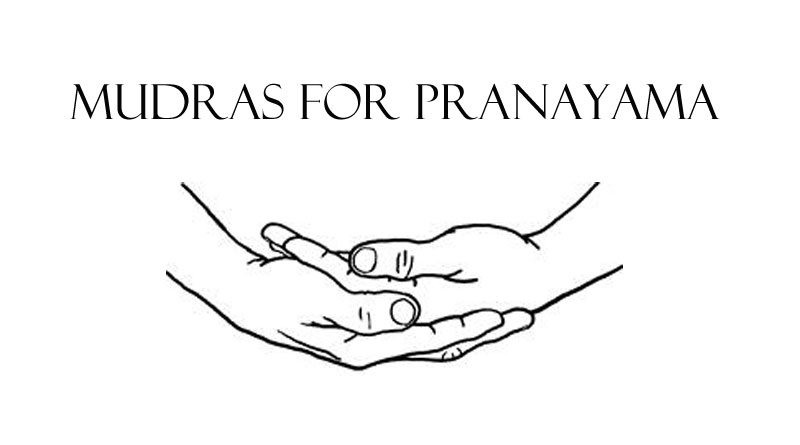
Mudra is a Sanskrit word that translates to “attitude” or “symbolic gesture”. There are many mudras associated with yoga. Those mentioned here are meant to effect the subtle, energetic body and are primarily used during pranayama practice. Their energetic effects also work on a subtle level of the mind and attitude.
(Color illustration by Laramie Sasseville)
With this writing we are referring to mudra as hand gesture, yet any specific position of the body can also be considered a mudra if the intention is to influence the mind /body connection on an energetic level. Mudras are part of a system in meditation whereby energetic circuits within the network of “nadis” are linked to enhance pranic flow.
We’ll be discussing a few key mudras here and how they influence and enhance pranic flow during pranayama or meditation.
*Mudras should be held in a relaxed way without tension.
Vishnu Mudra (hand gesture of Lord Vishnu) This is one of the hand gestures used to alternate the breath through the nostrils during Nadi Shodana . In this mudra the right hand is used as it is associated with giving while the left is associated with receiving. However if for whatever reason you need to use your left hand during practice that is fine. The thumb and fingers rest lightly just above the nostrils so very little movement is needed to close each side during practice.
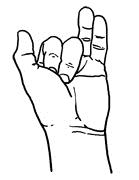
Chin Mudra (psychic gesture of consciousness) This mudra is used in either seated meditation or pranayama such as ujjayi. The hands rest on knees or thighs facing down. This Gesture has a grounding effect on the mind. The middle finger, ring, and little finger represent the three classic qualities of all of nature (the Three Gunas). The middle finger symbolizes sattva, (purity, wisdom and true understanding) the ring finger rajas, (action, passion and movement) and the little finger tamas, (inertia, lethargy and darkness). Classically the yogi is meant to transcend these states, progressing from darkness into light and from ignorance to wisdom.
Chin Mudra (psychic gesture of consciousness) This mudra is used in either seated meditation or pranayama such as ujjayi. The hands rest on knees or thighs facing down. This Gesture has a grounding effect on the mind. The middle finger, ring, and little finger represent the three classic qualities of all of nature (the Three Gunas). The middle finger symbolizes sattva, (purity, wisdom and true understanding) the ring finger rajas, (action, passion and movement) and the little finger tamas, (inertia, lethargy and darkness). Classically the yogi is meant to transcend these states, progressing from darkness into light and from ignorance to wisdom.
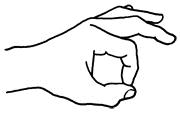
Jnana Mudra (psychic gesture of knowledge) In Jnana mudra the hands are placed on the knees in seated meditation with the palms facing up. This mudra gives a feeling of spaciousness and has a subtle uplifting effect on the body and mind. In both Chin and Jnana mudra the connection made by the thumb and index figure is said to create a kind of circuit by connecting the terminus of certain nadi thus re-circulating the body’s vital energy.
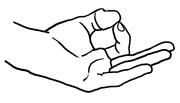
Chinmaya Mudra (gesture of awareness) This mudra is said to influence the prana in the thoracic area of the body.
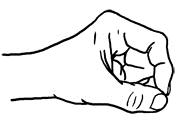
Aadi Mudra (primal or first gesture ) This mudra is made by curling the fingers around the thumb making a very light fist. It has a soothing influence on the mind and is said to positively influence breathing. Aadi mudra can be very useful in savasana at the end of asana practice to quiet the nervous system.
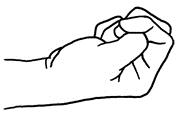
Brahma Mudra (gesture of all-pervading consciousness) This mudra is done and the fingers wrapped around the thumbs and the knuckles of both hands pressed together. The hands are then lightly pressed against the pubic bone. Brahma mudra helps to stimulate a full breath in pranayama practice.
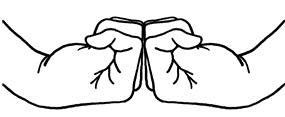
Bhairava and Bhairavi Mudra (fierceaspect of Shiva and Shakti) When the right hand is placed on top it is the Shiva aspect, Bhairava. When the left is on top it is Bhairavi, the Shakti aspect; consciousness and manifestation.
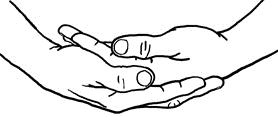
Prana Vayu Mudras (vital air gestures, not pictured) In the science of Ayurveda the qualities of the “five elements” orpancha bhutas of earth, water, fire, air and ether are connected to and represented by prana vayus (see The Five Pranas and Chakras). These energies are symbolized by the five fingers of the hand; the thumb represents fire, the index finger is air, the middle finger is ether and the ring finger is earth while the little finger is water.
The following five mudras are thought to directly influence the “five vital airs” or prana vayus in the physical body. With each mudra, the corresponding vayu is believed to be stimulated and bring a unifying effect to the various pranas.
Prana Mudra– Tips of middle and ring finger touch the tip of the thumb.
Apana Mudra-Tips of the index and middle finger touch the tip of the thumb.
Samana Mudra– Tips of the ring and little finger touch the tip of the thumb.
Udana Mudra-Tips of the index, middle, ring and little finger touch the tip of the thumb.
Vyana Mudra-Tips of index, middle, ring and little finger touch the tip of the thumb. (same as Udana)
Any of these mudras can be done during meditation with the mind fixed on the particular area of the body were the corresponding vayu is meant to reside. Bringing our conscious awareness to specific areas of the body helps direct the prana.





